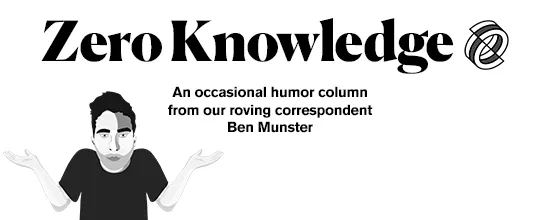
I expected a fairly lazy and hysterical recounting of the many ills of crypto when I began reading Popping the Crypto Bubble. The ambitious crypto-skeptical book was co-authored earlier this year by financial fraud writer Darren Tseng, fintech consultant Jan Akalin, and software engineer Stephen Diehl—notably, the organizers of September’s historical “no-coiner” conference.
Diehl is the most notorious of this trio. He regales his 58,000-strong Twitter audience with a daily deluge of epigrammatic, viciously cynical talking points that are a crypto-skeptical version of the vacuous sloganeering of Bitcoin booster bros like Anthony Pompliano.
Diehl ad nauseum blasts crypto as a “grift,” a massive “ponzi,” etc., etc., and it’s all gotten a little tiresome. What once may have read as righteous criticism has since congealed into another tedious dogma to be digested by the terminally online.
It's unbelievable that after everything that has happened in the last year, people still believe that there are any good actors in the crypto space. Fraud in crypto is not the exception; it's the norm. The whole space is a hive of scum and villainy.
— Stephen Diehl (@smdiehl) October 6, 2022
Still, Diehl et al’s book, which promises to “uncover the truth about the technology behind cryptocurrency, its political ideations and the narratives that drive the biggest economic bubble in the history of mankind,” was better than I expected. Although I was let down by a somewhat fatal tendency toward confirmation bias—I’ll get to this—it did present a sober articulation of the crypto-skeptic fears over the potential harms of crypto, and the cries of “bubble” and “Ponzi” were more nuanced than their usual Twitter equivalent—just barely.
The book's treatment of crypto as a “bubble" was interesting and well-researched. The writers describe the current crypto “bubblebath” not as a single, Tulip-like mania, but a machine capable of producing new manias (ICOs, Defi, NFTs, etc) endlessly. (Sounds impressive!)
The issuance of private currencies, speculation around unproductive enterprise, accounting fraud, cash-grabs wrapped up in the language of liberation, “financial nihilism,” all are in the history books if you look for them. Crypto’s main innovation, the authors argue, is that it resolves these disparate streams into one mega-fraud that is sold to credulous investors as a solution to the depravities of the very capitalism that has provided the fuel for its own insane growth.
The book is best when discussing what its authors see as the sheer waste of the crypto industry. Even its most ardent supporters can’t deny the massive electricity expenditure (which Bitcoin defenders say is a feature, not a bug; and yes, yes, The Merge fixed this for Ethereum, etc.) and the vast amount of capital that ends up getting either speculated into oblivion or poured into unproductive enterprise.
They deploy a novel term, “Blockchainism,” to describe the endless abortive “pivots” to blockchain by flailing legacy companies. Because of the tendency for millions of dollars to wind up in failed projects, the hands of scammers, or in dead wallets, the authors argue that investing in crypto is often a negative sum game—a situation in which more value is ultimately destroyed than created. Investing in, say, Apple stock will ideally increase wealth for all investors if the company itself grows; with many crypto schemes, there may be practically zero underlying growth and gains are merely the divvying up of a diminishing pool of capital among a few lucky, early investors.
The problem with the book is that the authors extend this credible challenge to the industry’s carnival-barking, speculative side into a general case against crypto ever producing anything of value, ignoring any argument that hurts their prior screed.
The authors are unwilling to dwell even momentarily on the possibilities for, say, new models of ownership or organization that the tech offers. They reductively split crypto “culture” into three camps (Austrian economists, techno-libertarians and cypherpunks) while ignoring the more modest aspirations of, say, left-leaning DAO founders who want to enshrine the cooperative model (DAOs are dismissed simply as a “form of regulatory avoidance” in two meager paragraphs), or web developers interested in micropayments.
Similarly the writers aim to impugn Ethereum with the pedantic argument that “smart contracts are not really smart contracts”—something any Ethereum dev will happily tell you. Apparently drawing on his own experience as a coder, Diehl further claims that Ethereum’s coding language, Solidity, is highly prone to error and almost impossible to test in a chaotic market environment.
Most new programming languages are shaky at first. Ethereum coding has actually come along leaps and bounds since the network’s inception in 2015, and now involves endless rigorous testing and “keywords” that help prevent programming accidents. Hence the success of the Ethereum merge—a technical feat which Diehl and co., as it happens, predicted would never happen due to technical limitations. (The book went to press before The merge was successfully implemented on September 15. Oops!)
Perhaps the tome’s biggest shortcoming is its authors’ confusion as to their own moral position on things like drugs, law enforcement, sanctions, technology, and Wall Street. They rail against the corrupt financial system that inspired crypto while often deferring reflexively to the opinions of that system’s chief exponents, among them people like Warren Buffett who have called for crypto’s destruction. They write approvingly of illegal torrenting networks like BitTorrent while decrying crypto’s use in any form of illegality on principle.
The ideological muddle goes on. As recent founders of an anti-crypto think tank called the “Center for Emerging Tech,” the writers clamor for more regulation and prosecution of crypto companies, at one point issuing, Economist-style, a numbered list of stern diktats to the American government. And yet, at the same time they seem mostly fine with the same venture capital model that led to some of the most catastrophic frauds of the last few decades (ahem: Theranos). Despite inveighing against capitalism, they conclude the book by declaring, “capitalism is not going anywhere anytime soon,” suggesting that ridding the world of crypto to retain the status quo is noble enough.
Perhaps this is all inevitable for a movement that has drawn its broad-based coalition of haters from so many disparate sources: the “legacy” finance world, politics, online activism, gamers, leftism, and a host of others all united in their crypto hatred.
Ultimately, Popping the Crypto Bubble did lend deeper analytical substance to the loudest skeptical talking points endlessly retweeted on no-coiner Twitter. But I came away with the sense that the authors were only successful in knocking down a strawman: a version of the crypto industry in which everybody is either a delusional libertarian fantasist or a vaporware-hawking tech bro.
Those types are only, like, 99% of the industry. And that remaining 1% could make the difference.


